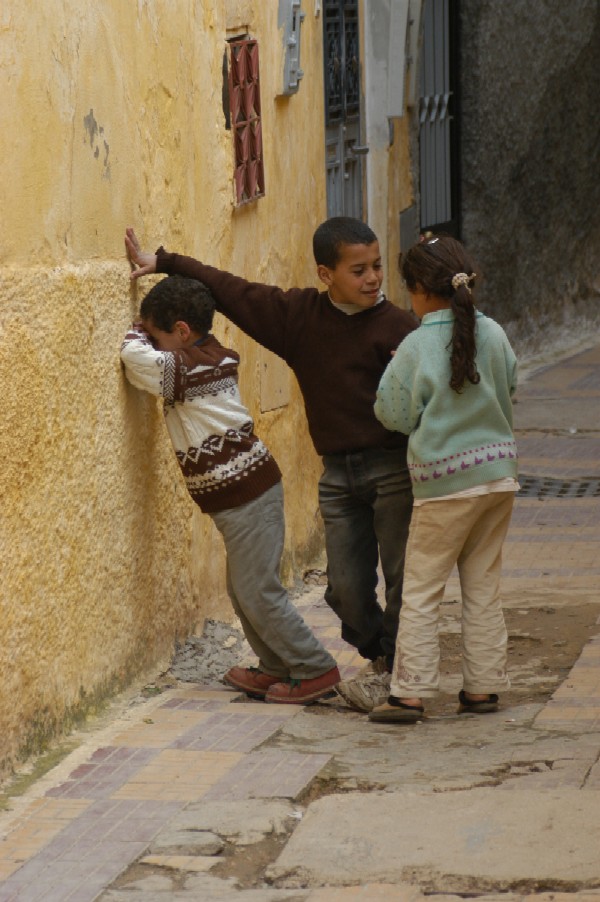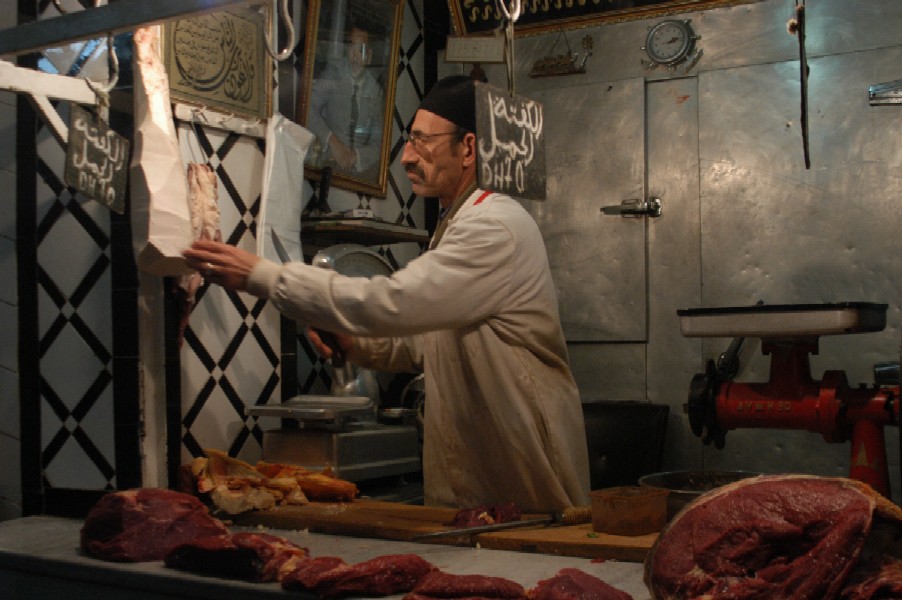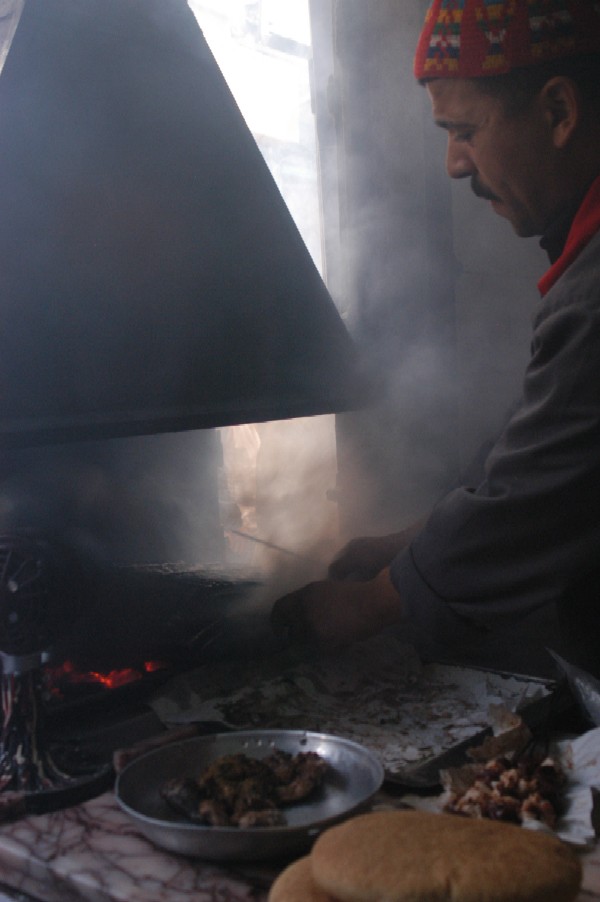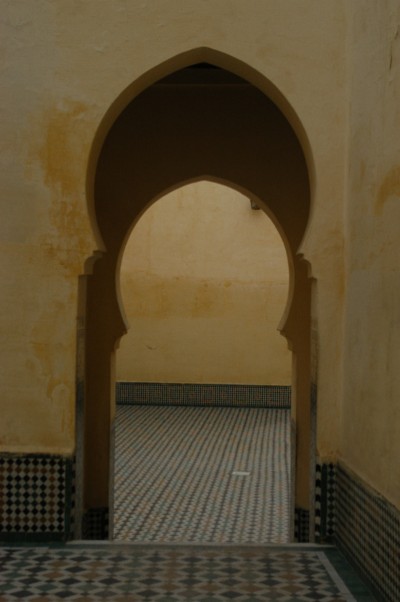May 8. MEKNES The cafe across the street had some nice pastries and was a good spot for breakfast. The waiter was really friendly and already recognized us. After breakfast we went to check bus times to Tenerir, our next destination in the Moroccan Sahara. We preferred to take CTM, rather than the dingy independent buses, and checked their schedule first.  They had a spiffy new bus terminal in new town that operated like a small airport. The guy at the desk was helpful but, unfortunately, the only bus they had towards the Sahara was at night. We caught a cab to the main bus station on the far side of the medina and noted the schedules there. They had a morning bus departure. They had a spiffy new bus terminal in new town that operated like a small airport. The guy at the desk was helpful but, unfortunately, the only bus they had towards the Sahara was at night. We caught a cab to the main bus station on the far side of the medina and noted the schedules there. They had a morning bus departure.
We entered the old medina from a colorfully tiled gate near the bus station. Using our guidebook map we tried to navigate to the main square but ended up far off our mark. While we thought we had reached the medina area we actually going around in the old mellah, a separate section of the medina that was originally built for the Jewish population. Fes had one as well. The mellah didn't have the most important buildings in the medina and, perhaps for that reason, didn't see as many tourists. Meknes didn't see as many tourists as Fes which probably also accounted for the pleasant welcome we received as we walked through the narrow streets of the Meknes mellah. A lively vegetable market was under way and the local people were quite happy to let us take some photos. A baker even let us peek inside his bakery and snap a few shots. The water men, characters dressed in red with a tassled hat, brass cups hanging off of them and a animals skin water container over one shoulder, were another story. They were a feature of all medinas and were popular photo opportunities so even the ones in Meknes were wise to the tourist dollar. I asked the first one we saw if I could take a photo. He asked for money so I didn't take the picture. As he passed a second water man we saw them briefly chat before the second one approached us. He had a leather satchel over one shoulder that had coins from different places hammered into the flap. He asked for a coin to add to his bag. Rob happened to have a Lithuanian coin on him and offered it to the man. He seemed happy. I asked if I could take his photo and he nodded. I snapped a couple of shots and then he asked for money. We shook our heads and said he had already agreed to the photos. Besides we had contributed to his coin collection. He tried to demand a dollar but we told him if he wanted money he needed to tell us before the photo was taken. He thought he had a strategy that would work, after consulting with his comrade but we didn't let him get away with it. No harm in him trying though. I am sure many tourists give in to him. briefly chat before the second one approached us. He had a leather satchel over one shoulder that had coins from different places hammered into the flap. He asked for a coin to add to his bag. Rob happened to have a Lithuanian coin on him and offered it to the man. He seemed happy. I asked if I could take his photo and he nodded. I snapped a couple of shots and then he asked for money. We shook our heads and said he had already agreed to the photos. Besides we had contributed to his coin collection. He tried to demand a dollar but we told him if he wanted money he needed to tell us before the photo was taken. He thought he had a strategy that would work, after consulting with his comrade but we didn't let him get away with it. No harm in him trying though. I am sure many tourists give in to him.
Our wander in the mellah finally led us to a large market outside the walls and we knew we had been in the wrong area. From the larger market we were able to find our place on the map and get ourselves to the bab el Mansour, the city's most famous gate, built in 1732. Compared to Fes, Meknes didn't have the historical charm. The city has suffered more destruction during history and they were just now getting on the tourist band wagon. The massive gate faced the main square where we stopped for some tea. I loved the mint tea but I think all of the sugar was starting to make my teeth rot.
There was a museum near that square that we wanted to see but it was closed for lunch. We took our guidebook's advice and went to try the camel butcher for lunch. His shop was in the middle of the medina, easily identified by the large slab of fatty camel hump hanging in front. Across the way was a beautifully stacked stall selling olives and preserved lemons. I looked at a photo in our guidebook and recognized the very same stall. He was quite unparalleled in his presentation. recognized the very same stall. He was quite unparalleled in his presentation.
The camel butcher didn't speak any English but we were not likely to have been his first tourists. Rob held out 30Dh and we pointed to the grinder. He motioned to the onion and cilantro. We nodded and he went to work. He chopped off some lean camel meat and put it through the grinder with a knob of hump fat and the onion and cilantro. He put the ball of ground meat in a plastic bag and motioned to a young man standing nearby to show us to the griller. Down an alley and around a corner there was a row of closet-sized eateries that were not much more than a grill and table. These tiny places even made the Golden Gai bars in Tokyo look spacious. Two men were working the shop, one at the grill (the owner) and his helper. Our guide said something to the griller and we handed over our meat. He already had several racks of meat going but he quickly shaped our meat into long meat balls and slapped them into a a rack. The rack clamped the meatballs between two sides and allowed the griller to kind of stack them over his grill. He moved them down as the bottom one was ready to eat.
 The griller had very little space behind the counter, pretty much wedged in between the grill, the counter and a small wall with a hole in it for passing food back to the table. Smoke bellowed from the grill. The small chimney just caught some of it and let the rest to swirl around us and seep out the door. There was a small entrance that passed his counter and led to the one table crammed in the back. Basically the table took up the whole area with bench seats attached all along the wall and just enough room to move around. There was a family busy consuming their meal and the subsequent customers were sitting in order along the bench as it wrapped around the table and out the door. It was so full that when we took our spot in line we were sitting right at the door. When the family got up the group shifted around. It didn't take very long to grill up the meat. We ordered two rounds of bread and a couple of teas to go with it. The helper wiped down the table before each customer and removed any left over bread to a drawer in the table. Bread is sacred to Islamic people and cannot be just thrown away. For the other customers he just tossed their bread on the table but for us he prepared a couple of pieces of paper so the bread didn't touch the table. The men seated around the table were entertained by our presence. None of them spoke any English but with some gestures and a few words of French we were able to answer questions like where were we from and where we were going in Morocco. When they left the gave us an enthusiastic "Bon Voyage!" And, the camel meatballs, I have to say, were delicious. The whole experience was great. The griller had very little space behind the counter, pretty much wedged in between the grill, the counter and a small wall with a hole in it for passing food back to the table. Smoke bellowed from the grill. The small chimney just caught some of it and let the rest to swirl around us and seep out the door. There was a small entrance that passed his counter and led to the one table crammed in the back. Basically the table took up the whole area with bench seats attached all along the wall and just enough room to move around. There was a family busy consuming their meal and the subsequent customers were sitting in order along the bench as it wrapped around the table and out the door. It was so full that when we took our spot in line we were sitting right at the door. When the family got up the group shifted around. It didn't take very long to grill up the meat. We ordered two rounds of bread and a couple of teas to go with it. The helper wiped down the table before each customer and removed any left over bread to a drawer in the table. Bread is sacred to Islamic people and cannot be just thrown away. For the other customers he just tossed their bread on the table but for us he prepared a couple of pieces of paper so the bread didn't touch the table. The men seated around the table were entertained by our presence. None of them spoke any English but with some gestures and a few words of French we were able to answer questions like where were we from and where we were going in Morocco. When they left the gave us an enthusiastic "Bon Voyage!" And, the camel meatballs, I have to say, were delicious. The whole experience was great.
 After lunch we visited the Merdersa Bou Inania, a modest little building tucked into the web of the medina. From the medresa we retraced our steps to the large square and found the Dar Jamai museum, built in 1882, just off of the large square. The museum was a large old riad with lovely stucco work and a good collection of tapestries. One of the attendants tried to nonchalantly latch on to us and give us a tour but we casually distanced ourselves. You can always tell when they are assessing the crowd to determine the more likely candidate for a tip. The other visitors were really young backpackers so we must have looked like a better shot. After lunch we visited the Merdersa Bou Inania, a modest little building tucked into the web of the medina. From the medresa we retraced our steps to the large square and found the Dar Jamai museum, built in 1882, just off of the large square. The museum was a large old riad with lovely stucco work and a good collection of tapestries. One of the attendants tried to nonchalantly latch on to us and give us a tour but we casually distanced ourselves. You can always tell when they are assessing the crowd to determine the more likely candidate for a tip. The other visitors were really young backpackers so we must have looked like a better shot.
After the museum we returned to the square for some coffee and then headed over to see the Mausoleum of Moulay Ismail, one of Morocco's greatest figures. He ruled for 55 years from 1672 and brought Meknes back from obscurity by making it his capital. When he died in 1727 the city went into decline with the 1755 earthquake really shaking it to its knees. The mausoleum wasn't so big as it was elegant and imposing with its warm yellow walls and beautifully maintained stucco and woodwork. The understated plain yellow walls of the three courtyards leading to the main room were in direct contrast to the impressively ornate interior. It is one of the few important religious places in Morocco that are open to foreigners. Out of respect I covered my head before entered and was appalled to find a French tour group exiting in tank tops and shorts. It is really no wonder that local people take such a dislike for tourists when they display such total disregard for local customs. The Vatican just wouldn't have let them in! 
From the mausoleum we found our way out of the medina and walked to McDonald's for some ice cream. It was as busy as the day before and the number of mothers there with children made it clear why it was so popular. While cafe society is off-limits to women in Morocco this enigma of a place was somehow acceptable and gave the kids a play ground to keep them entertained.
During the evening we just left the hotel to check email. The camel meat kept me full and Rob just grabbed a sandwich. |

